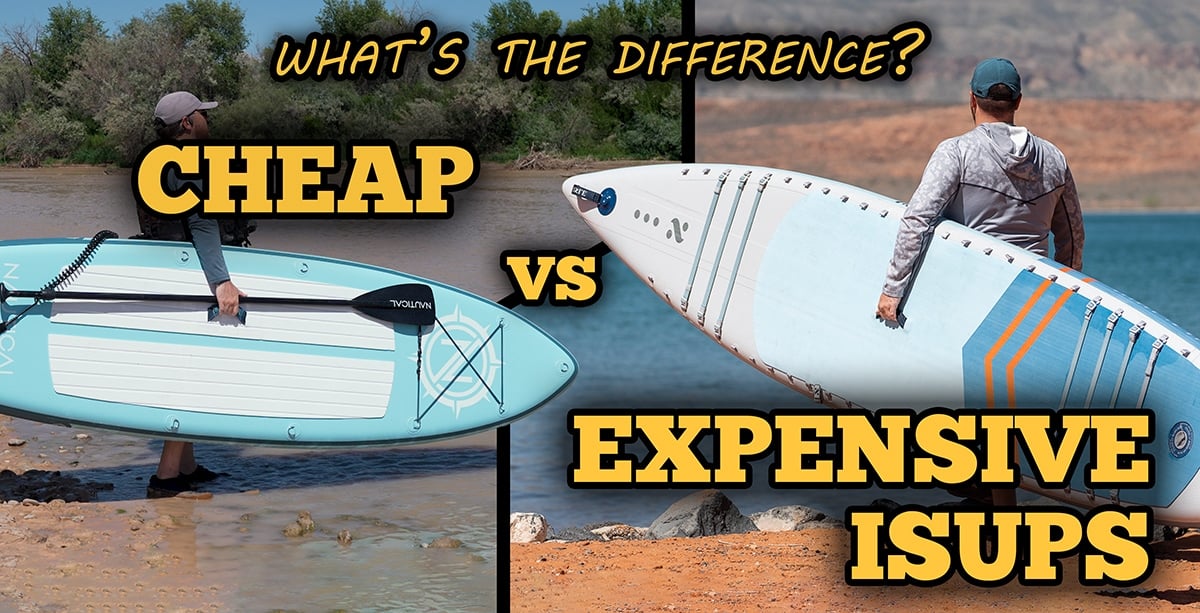
Quality iSUPs are a better value and investment than cheap iSUPs
I see this question come up frequently on paddle boarding social media groups. Unfortunately, asking a group of random strangers on the internet isn’t always the most reliable source of information. I’ve seen answers to this question that range from “that’s almost right” to making things up with no source for those claims. Occasionally, and not often enough, there are some good answers out there as well, but they unfortunately tend to get outnumbered by those that are just plain wrong.
So I’m glad you came to us for an answer! Aside from performing our own in-depth, quantitative, testing, we talk directly to the people that make these products and ask deep, technical questions. Understanding the differences between SUPs is not just our job, but our hobby as well. We get the opportunity to use arguably more different paddle boards than just about anyone else on the planet! I’ve personally tested well over 100 inflatable SUPs myself.
Let’s Talk Price
Inflatable Paddle Board pricing covers an absolutely huge range. From less than $200 for an entire kit to over $2500 for just a board. So what constitutes cheap or expensive? It can be hard to differentiate as well since some boards include a variety of accessories and others do not. However, it is rare to find stand-alone iSUPs for sale below a certain price point. Stand-alone iSUPs are almost always higher-quality boards that are designed for higher performance. Things like paddle selection make a big difference in how the boards perform for each paddler, so it’s better for the brand and the customer to have the board sold separately from these other personal-decision accessories.
General Pricing
I typically break iSUP pricing down into a few different categories based on their average price outside of holiday sales. However, many brands, especially brands with lower quality boards, also artificially inflate their MSRP and then offer the board permanently at a lower price. A classic example of this is Body Glove’s Performer iSUP which is listed as an insane $1,000 iSUP kit on their website, but is always sold at Costco for around $250. These sales tactics can make it more difficult to compare, but generally plague Cheap boards far more frequently than even just inexpensive iSUPs.
- Cheap – Boards/Kits under $300
- Inexpensive – Boards/Kits $300-$500
- Mid Range – Boards/Kits $500-$800
- Specialty – Boards $800-$1200
- Performance/Expensive – Boards over $1200
Now, these categories are not carved in granite. There’s all sorts of wiggle room between them, particularly when comparing iSUPs that are sold directly to paddlers from the brands versus boards that are sold through retailer networks. Examples of Direct to Consumer brands are iRocker, Thurso, Sea Gods, Hydrus, Gili, Isle, and many more. Examples of retail brands are Red Paddle Co, Starboard, Bote, NSP, Tahe and others. The benefit of a retail brand is you can sometimes walk into a physical store and view/handle the exact board you can purchase (if there is one near you). This does come at the literal cost of an additional layer of price markups for the retailer’s profit. So similar-price boards from each of these two types of brands may have vastly different qualities.
What are the Key Differences Between Cheap iSUPs and Expensive iSUPs?
It doesn’t necessarily take jumping straight to an “expensive” iSUP in order to get a higher quality iSUP. Even taking the jump to just a $500 or $600 iSUP can often result in massive increases in quality and performance.
Cheap iSUPs
Here’s a general breakdown of what you can expect from a Cheap iSUP (under $300 MSRP)
- Lowest quality materials in both the drop stitching and PVC
- Single layer liquid PVC for the shell
- Single or double layer PVC rails
- Generic shapes
- Proprietary fin boxes or fixed fins
- Lowest quality accessories
- Minimal or no warranty and customer service
Often these are boards by brands that don’t paddle or know anything about SUP, but have simply jumped on the bandwagon of a growing sport with a low-cost product. We actually don’t review many of these types of products at all as we find them to offer drastically inferior performance and reliability to even the slightly more expensive “Inexpensive” iSUPs.
This all typically results in a board that is not rigid when inflated and may have lower maximum inflation pressures, has cosmetic problems, may fall apart quickly (I’ve personally seen a number of these types of boards fail while being inflated), has limited or no access to replacement parts and no way to actually get in contact with the brand or seller to utilize a very short return or warranty period. These ultra cheap boards tend to work OK on the water, but bend noticeably for riders over 180 lbs, perform poorly, aren’t as stable as a higher quality board, and are not reliable for regular use.
Inexpensive iSUPs
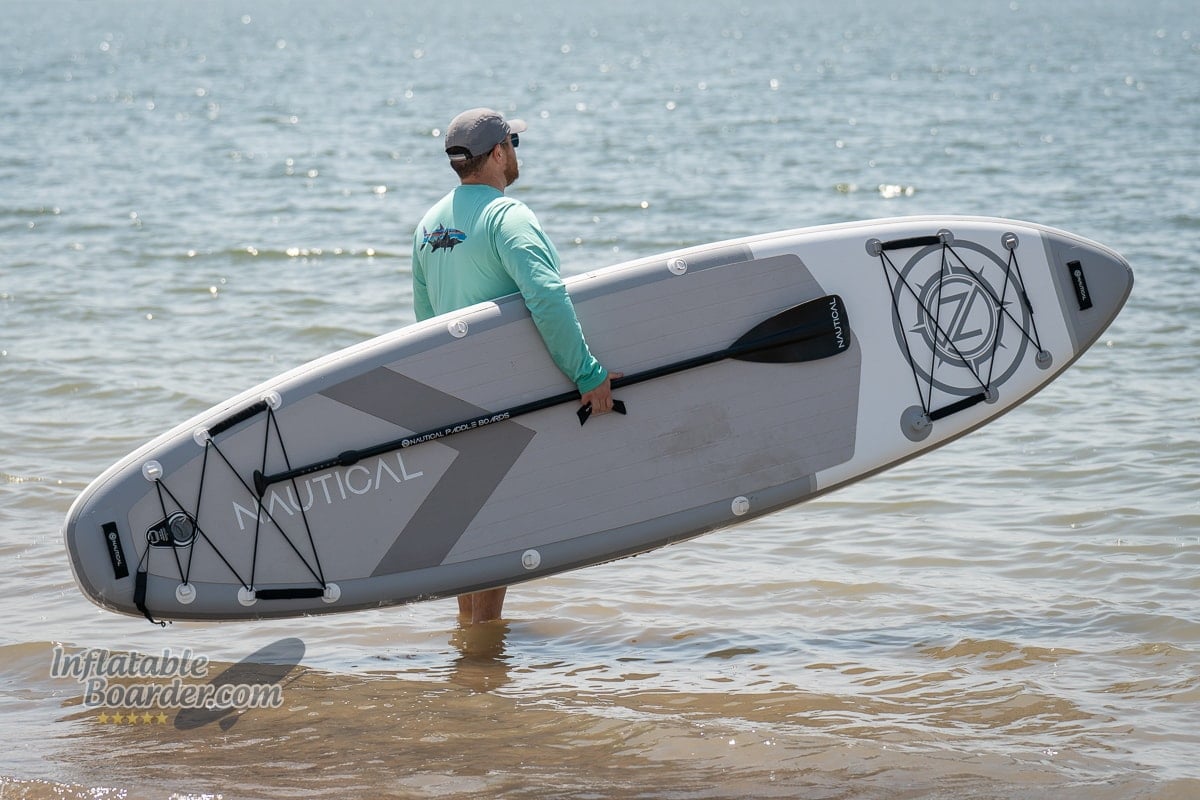
The Nautical iSUPs by iRocker are a great example of an inexpensive paddle board that still performs well, offers a multitude of features, and is reliable.
Here’s a general breakdown of what you can expect from inexpensive iSUP packages between $300-500.
- Basic materials for the drop stitch and PVC shell
- Single layer liquid PVC or single layer fusion PVC shells
- Double layer PVC rails
- General all-around shapes only
- Simple fin boxes
- Low-to-mid quality accessories
- 2 year warranties
These types of boards are usually sold by SUP brands as a budget friendly option, though there are many cheap boards on the market that bleed into this price range as well. The best way to tell them apart is by looking at the brand. Is it a paddle board specific company or is it a generic reseller on Amazon / “we sell everything from blenders to SUPs to tires” type company. It’s always better to go with a SUP-specific brand. These boards will last for many years, carry a good warranty, and perform well on the water for paddlers with an appropriately sized board.
Mid Range and Specialty iSUPs
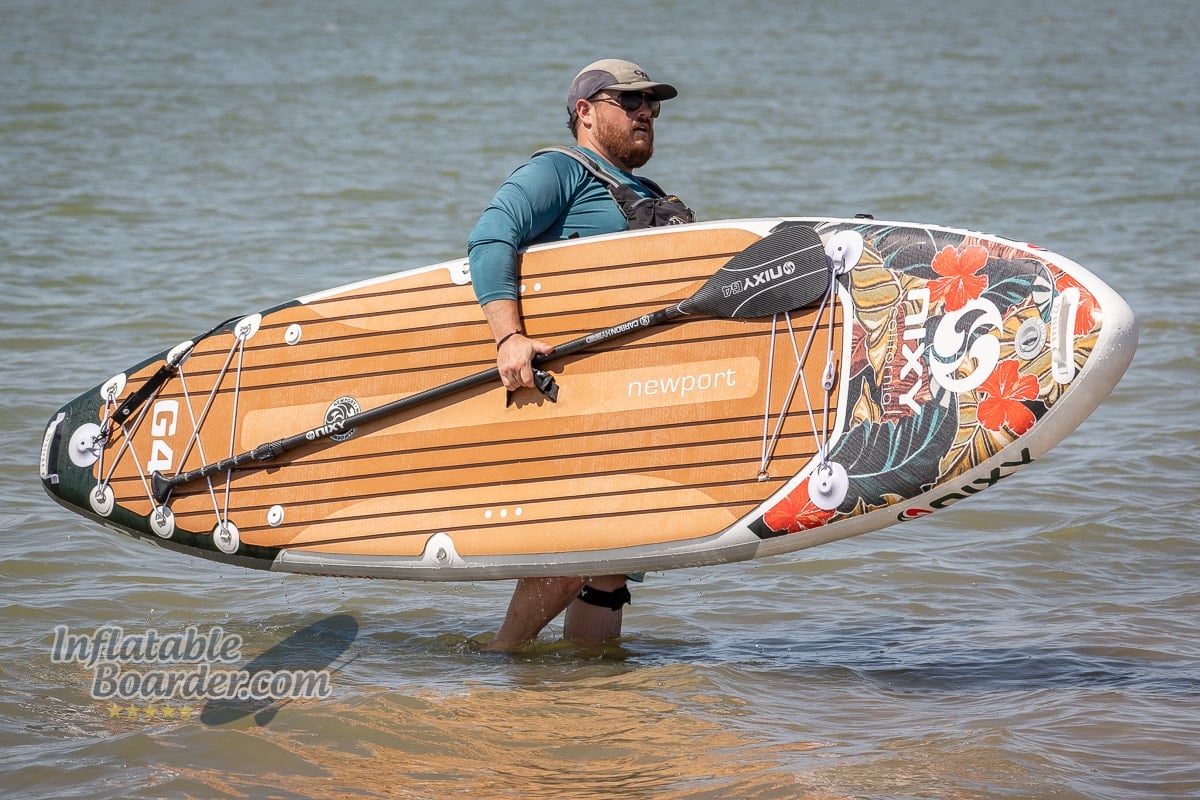
iSUPs in the mid range price category offer excellent performance and quality at a reasonable cost.
Here is what you can expect from a high-quality mid range or specialty iSUP generally $500-$800 for a mid range board and $800-$1200 for a specialty board.
- Advanced materials in the drop stitch core and/or PVC shell
- Double layer PVC shells, typically Fusion construction
- Double layer PVC rails
- May have additional stiffening systems like carbon fiber rails or stringers
- Customized shapes for better performance
- Some differentiation for specific types of paddling
- Additional on-board features
- Standardized fin boxes and fins
- Higher quality accessories – particularly bags and paddles
- Significantly long warranties (2-10 years) and improved customer service
These boards are made by dedicated SUP companies. They participate in and understand the sport to extremely high degrees and make products to advance the sport as a whole. Together these features allow for iSUPs that are extremely rigid when inflated, often have high inflation pressures (up to 20 PSI), few to no cosmetic issues, excellent durability and longevity, easy access to replacement parts, easy access to brand customer service, and a high quality warranty policy. These boards perform well for riders of all sizes, offer great stability and paddling performance, and are reliable for years of regular (and hard) use.
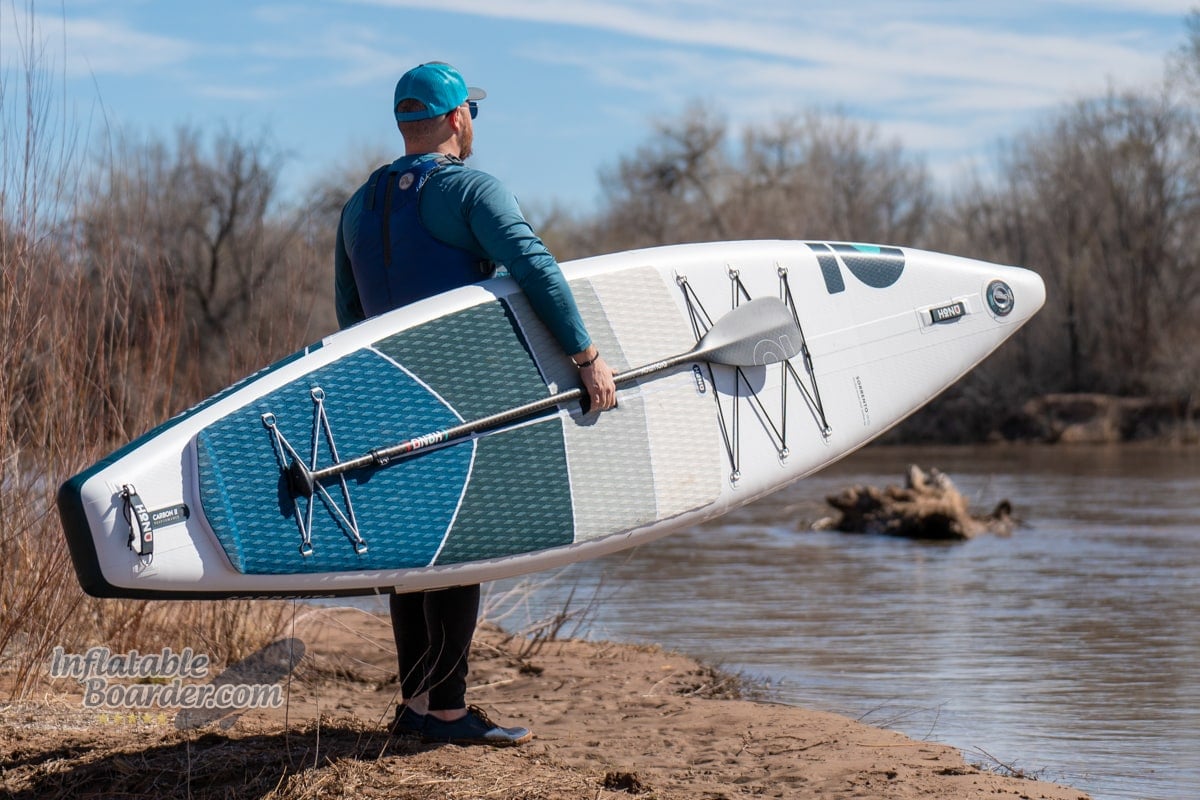
Specialty iSUPs offer great performance, quality, and shapes designed for a specific type of paddling. The Honu Sorrento is a specialty touring/fitness iSUP.
Specialty iSUPs have shapes, sizes, and features that are develop for a specific activity like touring, fishing, surfing, or yoga. These boards tend to blend the line between Mid Range and Performance iSUPs with elements of each. Generally they are a little bit more expensive than a mid range iSUP because of larger sizes, additional features, and/or lower demand.
Performance iSUPs
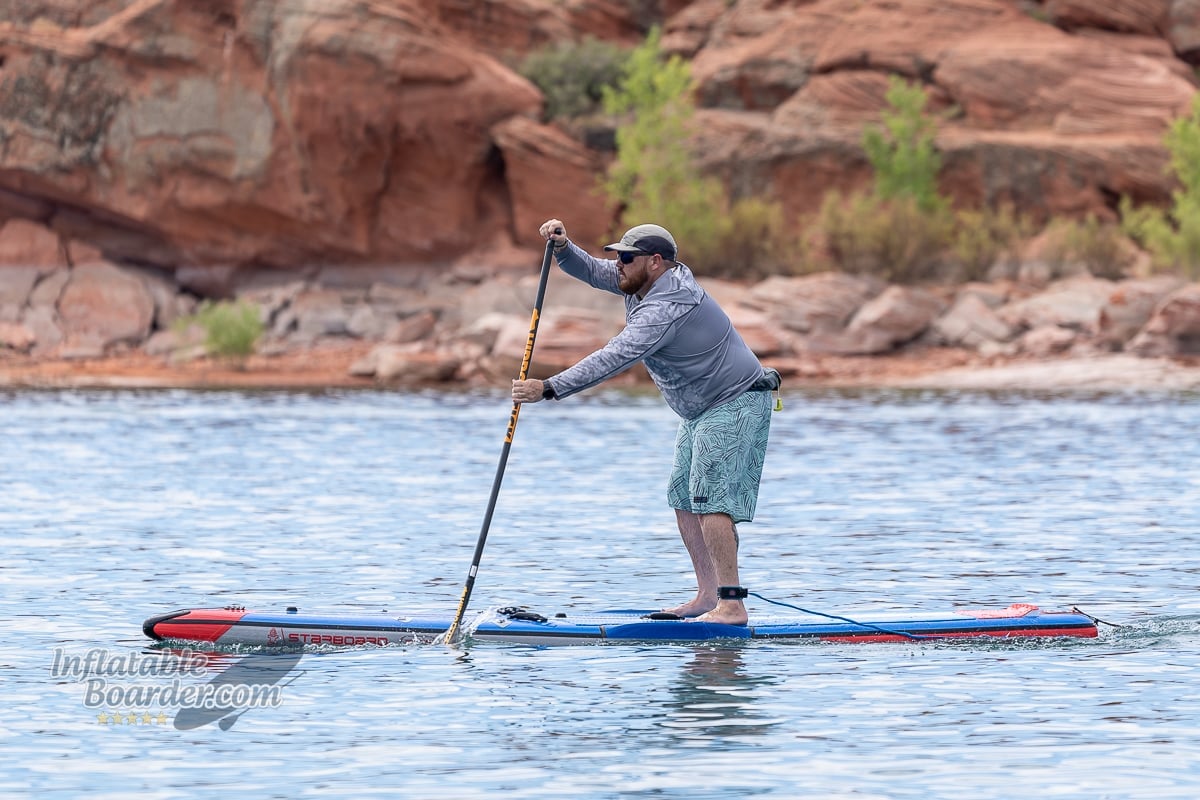
The Starboard All Star Airline is a performance iSUP that is specifically designed for racing. It’s not beginner friendly and comes at a steep price, but rewards its users with top-notch performance.
There are a handful of SUP brands that make highly specified iSUPs for things like competitive racing, surfing, whitewater, etc. that are in lower volume demand, but require an extra high degree of consideration in their design and construction. These boards generally cost $1000-$2000 for the board only (or with a minimal kit) and typically have:
- Cutting edge materials and construction techniques. These are the ground-breaking boards that experiment with all sorts of exotic materials and methods that sometimes trickle down to mid range boards after a few years
- Advanced stiffening systems using unique methods
- Utmost detail to construction to achieve a very specific performance mark
- Unique shapes and sizes not necessarily suitable for all paddlers
- High quality accessories when included (usually fins and bags)
- Excellent brand interaction with great warranties and customer service
These performance iSUPs aren’t for everybody, but for the paddler who knows they want them, there’s no alternative. These boards are only produced by companies who are deeply ingrained in the sport (and sub-sport).
What Specifically Drives iSUP Pricing?
If we were talking about a very basic item like lumber it’s pretty clear to see what may drive the price differences. Physical size, species rarity, and clarity are all very easy to discern. However with more complex products, like an iSUP, it’s much harder to “see” these differences.
Materials
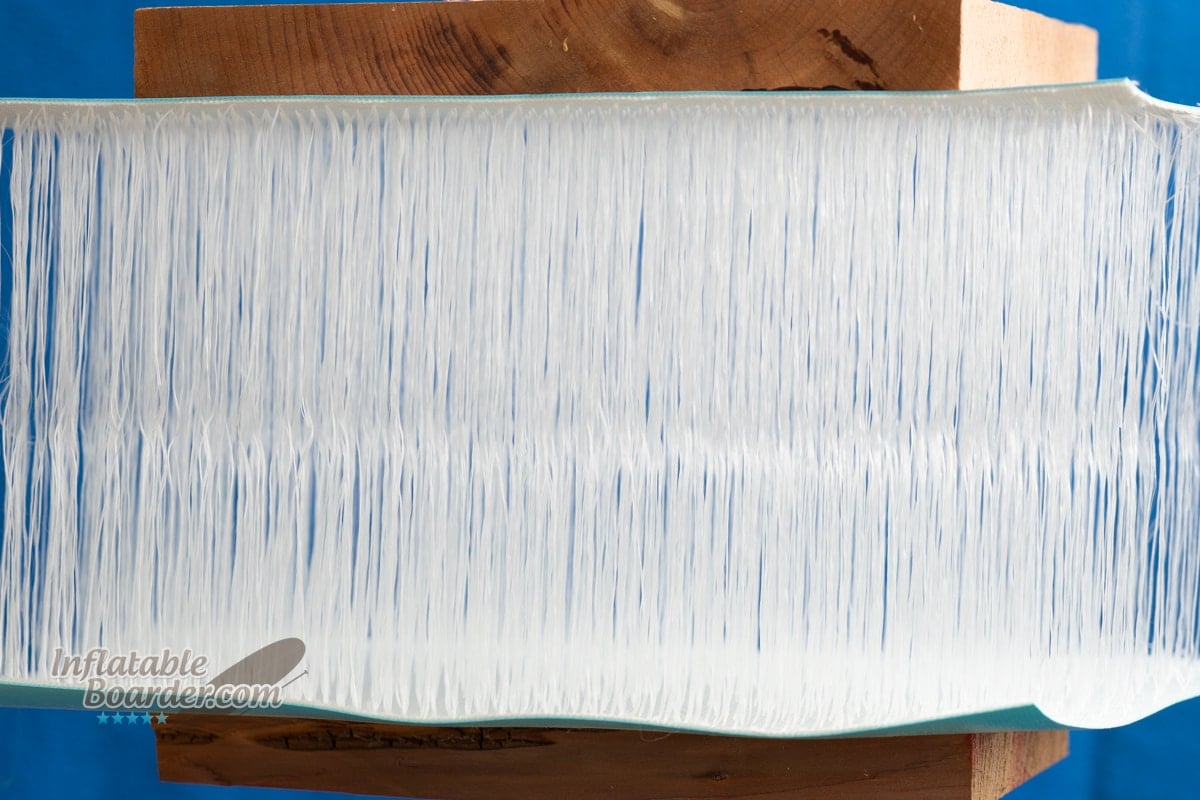
The double-wall fabric core of an iSUP is made of two pieces of polyester fabric connected with thousands of drop stitch yarns. The exact type of materials and stitching can vary greatly between boards.
Starting with the most basic components are the actual materials that make the board. Not only are there different types of materials involved, but they can be used in different quantities. Both the type and amount of a raw material used can influence price. Some materials may be more easily available and cost less, while more specialty or custom materials are made in lower quantities and cost more – like a pine 2”x4” versus a slab of veneer-quality walnut burl.
Construction and Manufacturing
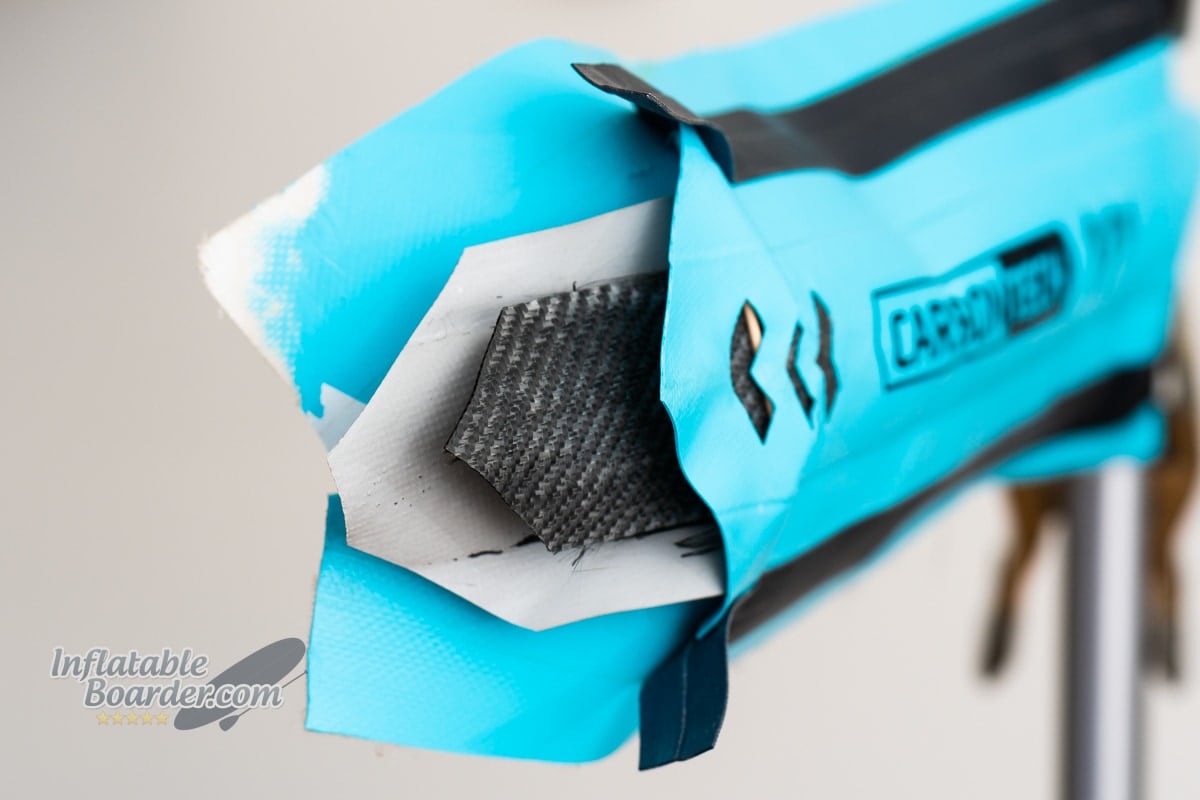
How the paddle board is physically put together has a huge impact on its price and longevity.
How the materials are then assembled and how they are assembled can vary from board to board. Some types of materials and manufacturing techniques require more hours of labor to complete or may require special machinery. For example, dual-layer Fusion PVC is less labor-intensive to make than hand-glued dual-layer PVC, but also requires specialized machinery to create. Welding seams rather than gluing them requires both specialized equipment and specially trained workers to operate those machines. Further, some brands opt to slow down their manufacturing processes. This slow down results in a higher degree of quality and accuracy in the construction (particularly cosmetically), but does require more hours of labor (and cost).
For more detailed information about types of materials and constructions used in inflatable paddle boards, check out our iSUP Construction 101 blog post.
Quality Control, Warranty, and Brand Size
Two more factors that go into the price of any iSUP are the quality control measures that go into the manufacturing process (and beyond) and the warranty provided by the manufacturer. Quality control checks can range from nothing to factory inspections to hand inspections for every board prior to shipping.
Warranties don’t necessarily cost anything upfront for a brand to provide, however they can cost brands on the back-end. If a brand were to offer a 10 year warranty on a very poorly made product, they’d quickly go out of business. So longer warranties are a good sign that those brands take extra care in their materials selection, manufacturing processes, and quality control measures.
Lastly, the size of the brand itself can make an impact on price in multiple ways. Large brands that produce thousands and thousands of products can get better rates by buying their materials in bulk and committing to so many units of production each cycle. Companies that have more employees also have more overhead. This can go either way, though depending on things like corporate structure and ownership. Smaller companies are able to keep costs lowered by handling many aspects of the business themselves. One of the main areas is customer service. Large companies may either rely on retailer networks or outsourced customer service for the bulk of it (which is costly) while small companies can handle customer service with their own in-house staff, often including the owners!
Design and Speciality
As brands can lower costs by increasing production numbers, that isn’t always possible when considering specialty equipment. While all-around iSUPs are in high-demand as great entry-level boards, specialized iSUPs for whitewater, surfing, foiling, and racing are in much lower demand. So brands build fewer of them and the costs are then higher per piece built.
The design of the board itself is also a factor. While it’s possible for anyone to go to AliBaba and order a container full of generic shaped iSUPs at very low costs, it takes far more time, effort, experience, knowledge, and cost to develop a custom shaped iSUP.
Accessories
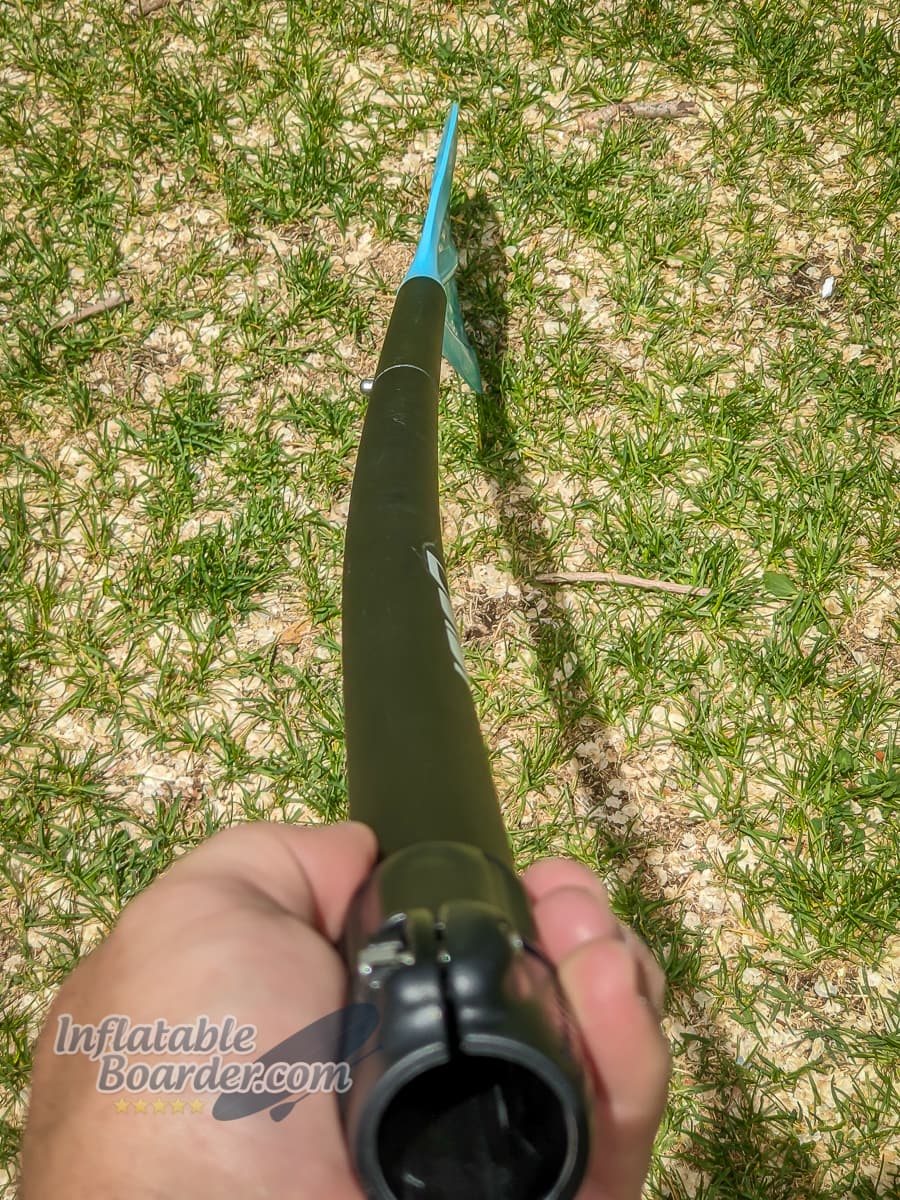
This cheap aluminum paddle bent while paddling after just a couple of uses. Aluminum paddles are inexpensive, but heavy and cannot be reliably repaired from damage like this.
Just like with the iSUP itself, all of the included accessories have the same set of factors affecting price. The materials, construction, design, manufacturing, customization, and quantity of included accessories (fins, bags, paddles, pumps, leashes, etc) all affect the price of the kit.
Final Thoughts on Cheap vs Expensive iSUPs
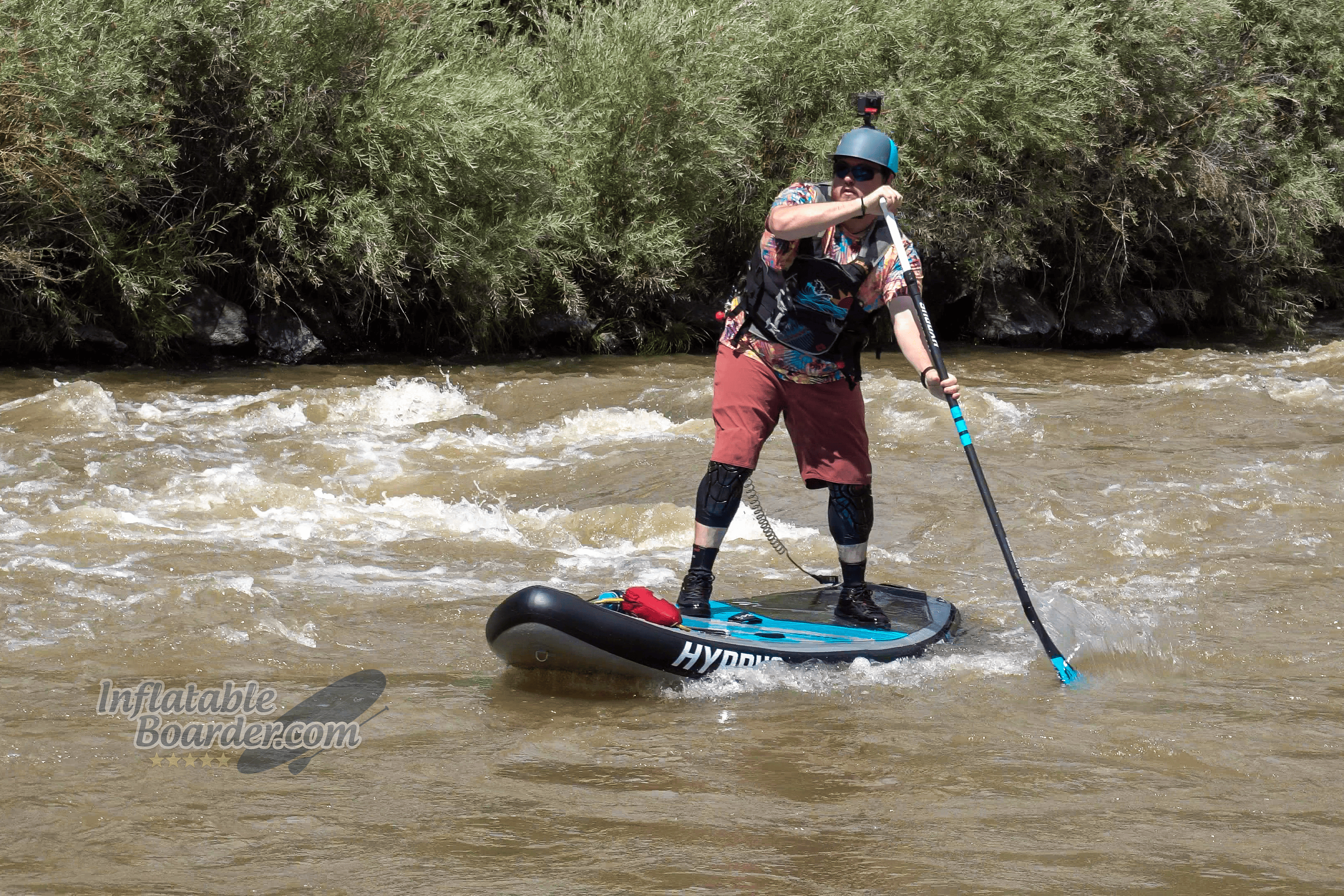
iSUP quality matters when it comes to having a fun, and safe, time on the water. While cheap iSUPs may be okay to use for a handful of times, their reliability and performance quickly leaves paddlers wanting more.
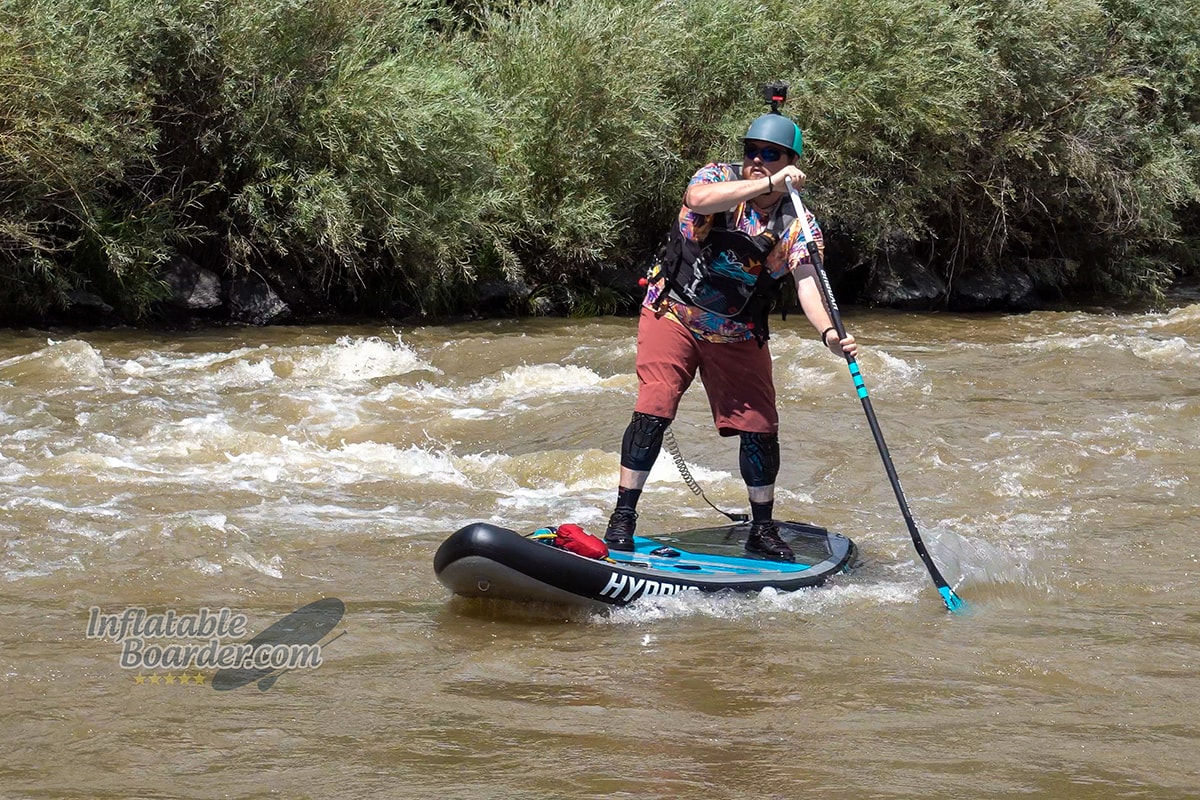
Cheap iSUPs are often purchased as impulse buys from big-box stores or with the thought of “I’ll buy it cheap and if I like it then I’ll buy a better one.” The problem with that is the lower-quality boards are often awful on the water. They aren’t stable, they don’t perform well, and they fall apart quickly. Any of those can easily sour the taste of the sport for a new paddler. There’s also two additional costs to this mindset of buying it twice. The first is the literal cost. If you go into it with this mindset, then when you do buy the midrange board all you’ve done is made it more expensive for yourself, because I guarantee you’ll never choose the cheap one over the midrange one again once you’ve tried them both.
The other cost to a cheap iSUP is the environmental cost. There’s no beating around the bush, PVC is not an environmentally friendly material. It’s a plastic (thus petroleum-based), it’s not readily recyclable except by a few very specific facilities worldwide, and as a material it can persist for a very, very long time. So when you decide halfway though your first season to upgrade, or when that cheap iSUP does fall apart, it often just becomes fodder for the landfill.
Buying a high-quality iSUP doesn’t necessarily mean buying an expensive board. You can get a great board that will be reliable for years and years of use at a very reasonable price. If you are new to the sport and want to try it first before buying a board, my advice as a paddler and a SUP instructor is to rent, or better yet, take a lesson or two. You’ll save a ton of money (rentals are as little as $15/hour depending on location), and a lesson is the quickest way to climb the learning curve and do so with correct technique to set you up for future success. Then, when you’re ready, you’ll be comfortable knowing that buying a high-quality board is absolutely worth the investment.



Leave a Reply